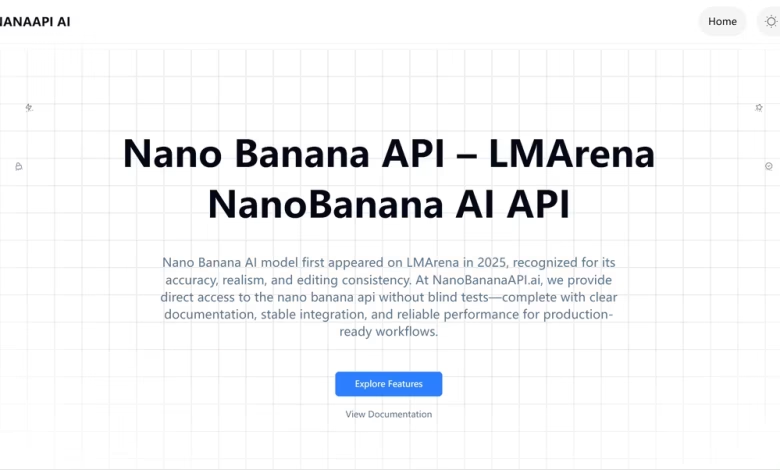
In recent months, the Nano Banana AI—also known as the Gemini 2.5 Flash Image—has quickly gained traction among developers. Its ability to handle both AI image generation and AI image editing with realistic, physics-aware outputs makes it one of the most versatile tools available today. While Google provides official access to the Nano Banana API, the costs and setup complexity can feel overwhelming for smaller teams.
That’s where NanoBananaAPI.ai comes in. With straightforward API documentation and affordable Nano Banana API pricing, developers can start building with advanced AI image tools in just a few minutes. In this guide, we’ll walk you step by step through how to quickly integrate the Nano Banana API into your projects.
Nano Banana Model Enhances AI Image Editing Integration
Speed and Consistency Combined
The Nano Banana model, built on the Gemini 2.5 Flash Image API, is optimized for fast generation while keeping outputs stable. Characters, styles, and design details remain coherent across multiple generations, which reduces rework and keeps pipelines predictable.
Precision Editing with Realism
The Nano Banana AI API supports localized edits that target only the specified areas—such as object replacement, background changes, or lighting adjustments—without introducing unwanted modifications elsewhere. Combined with physics-aware rendering, the outputs preserve natural shadows, reflections, and textures.
Multi-Image Fusion for Creative Flexibility
The Nano Banana AI model allows developers to blend multiple input images into a single result, enabling complex compositions and creative experimentation. By merging concepts, references, or environments, the model expands possibilities beyond single-prompt generation.
Nano Banana API Pricing Comparison: Why NanoBananaAPI.ai Stands Out
When evaluating Nano Banana API pricing, one of the first challenges developers face is balancing cost with performance. The official Google Nano Banana access through AI Studio or Vertex AI charges around $0.039 per image. While reliable, this rate can quickly add up for small teams generating thousands of images each month.
Platforms like Fal.ai also provide access to similar models at nearly the same cost, typically hovering around $0.039 per image. For indie developers and startups, this leaves little room for experimentation or scaling without overshooting budgets.
By contrast, NanoBananaAPI.ai offers the same Gemini 2.5 Flash Image capabilities at just $0.020 per image—almost half the price of competing options. Combined with flexible, credit-based billing, developers can start small, scale confidently, and predict costs without being locked into heavy subscription fees.
This balance of affordability, clear Nano Banana API documentation, and developer-friendly access through a secure API key makes NanoBananaAPI.ai the most practical choice for those who want enterprise-grade AI image generation and editing without the enterprise-level price tag.
How to Integrate the Nano Banana API Quickly on NanoBananaAPI.ai
Integrating the Nano Banana AI API—powered by the Gemini 2.5 Flash Image—is a streamlined process designed for developers who want results without unnecessary complexity. The workflow involves just a few clear steps, backed by straightforward Nano Banana API documentation.
Step 1: Generate Your Nano Banana API Key
Start by creating an account on NanoBananaAPI.ai. From your dashboard, you can generate a secure Nano Banana API key, which is required for all requests. This key acts as your authentication token, ensuring secure communication with the API.
Step 2: Create a Task for Image Generation or Editing
With your API key ready, the next step is to set up a task. Each request specifies the model (google/nano-banana) along with parameters such as the prompt (for text-to-image generation), output format, and image size. Developers can also configure a callback URL for asynchronous workflows, which is particularly useful for scaling projects.
Step 3: Retrieve and Manage Results
Once the task is submitted, you can check its progress using the task ID. The recordInfo endpoint provides real-time status updates, while completed jobs return direct URLs to the generated images. For large-scale applications, callback notifications automatically deliver results, making the system efficient and production-ready.
This integration flow strikes a balance between simplicity and flexibility. With a secure Nano Banana API key, clear API documentation, and affordable Nano Banana API pricing, developers can bring advanced AI image generation and editing into their apps in just a few minutes—without the cost and complexity of relying solely on Google services.
Bringing AI Image Editing to Your Projects Faster with Nano Banana API
The Nano Banana AI model (Gemini 2.5 Flash Image) shows how far image generation and editing have come—fast results, realistic details, and flexible ways to shape outputs. For developers, the challenge is not the capability of the model but how to integrate it in a way that’s practical and cost-effective.
By providing affordable Nano Banana API pricing, secure access through an API key, and a workflow that can be set up instantly NanoBananaAPI.ai makes it easier for teams to adopt advanced AI image capabilities. For developers looking to bring AI image editing and generation into their projects quickly and cost-effectively, it represents a clear and reliable option.


